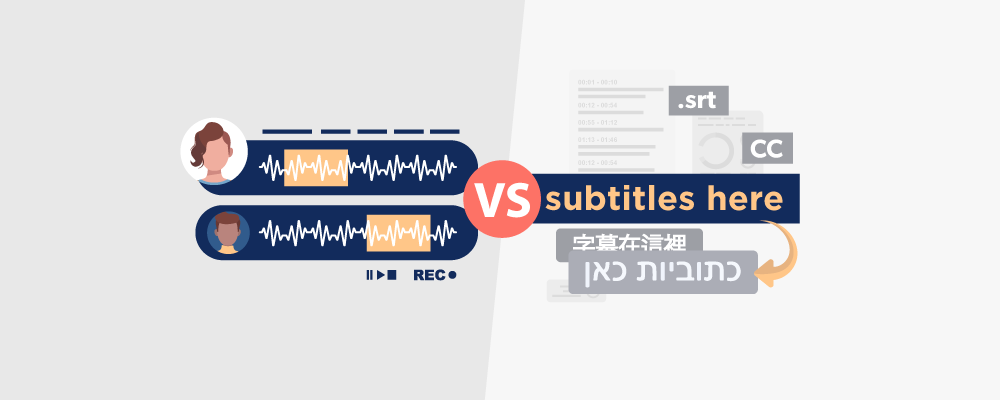As the demand for video content translations grows, one of the most significant decisions a business has to make is how best to localize its audiovisual presentations into multiple languages. This article discusses the pros and cons of two commonly used methods: subtitling and voice-over services. We compare these two approaches and identify the best solution for your needs.
What is Subtitling?
Subtitling is translating and displaying written text on screen, usually in the form of subtitles. You find them in films, TV shows, and other video content. On the other hand, voice-over is the process of recording someone speaking in another language and overdubbing the audio track over the original video. At Prime Group, we select and record native, professional voice talents to dub videos and animation.
So, which is better? It depends on your specific needs and preferences. Here are some things to consider when making your decision:
Target audience
Are you targeting a global audience or people who speak another language? If you’re only targeting people who speak another language, then subtitling might be the better option since it’s cheaper and easier to produce. However, if you’re targeting a global audience, voice-over might be a better choice since it allows everyone to understand the content regardless of their native language.
Content type
What type of content are you localizing? Suppose it relies heavily on visuals, such as an animation or an explainer video. In that case, voice-over may not be necessary, as the visuals can convey the meaning of the content without the need for audio. In such cases, subtitling might be a better option since it doesn’t require redubbing all the audio and allows the viewer to focus on the visuals. Voice-over is ideal, though, when too much On-Screen-Text appears on the video. Subtitling convolutes the meaning. Voice-Over is also more effective in conveying the message with all feelings and emotions.
What is Voice Over?
Voice-over is an audio recording of someone speaking over the top of a video. The voice-over artist will generally not be seen on screen, and their voice will be used to provide information about what is happening in the video or to provide narration.
Voice-overs are often used in documentaries, corporate videos, and explainer videos. They help provide information about a product or service, tell customers how to use something, or provide educational content.
At Prime Group, we record voice-over in any language. This localization with the human voice is ideal for multilingual content localization. A good voice-over artist will be able to change their tone and style to suit the content they are voicing, and they will be able to deliver the lines with feeling and emotion.
There are two main methods for translating multimedia content: subtitling and voice-over. Both have pros and cons, which should be considered when deciding the best solution for your project.

Pros and Cons of Subtitling
Subtitling is generally the most affordable option because it doesn’t require hiring a voice talent. It can be a good choice for time-sensitive projects. Subtitling can be more challenging than voice-over, as viewers must keep track of both the onscreen action and scrolling text. This can be incredibly challenging for viewers unfamiliar with the source language. Subtitling can be intrusive and disrupt the viewing experience.
In summary:
Subtitling Pros:
1. Subtitles are more cost-effective and quicker to produce than voice-overs.
2. They can be easily added or removed from a video without affecting the original audio track.
3. Subtitling can make content more accessible to viewers with hearing impairments or watching without sound.
4. Viewers can watch a video at their own pace, pausing or rewinding if needed.
Subtitling Cons:
1. Some viewers may find subtitles distracting or difficult to read if they are not used to them.
2. Subtitles cannot convey emotional cues or intonation in the same way that voice-overs can.

Pros and Cons of Voice Over
On the other hand, voice-over creates a more immersive experience for viewers as they don’t need to focus on reading subtitles. This can be especially beneficial if you’re targeting a foreign market that may need to become more familiar with the source language. Voice-over is less likely to interfere with your content’s audio/visual quality. However, it is generally more expensive than subtitling due to the need to hire additional voice talent. Additionally, voice-over can take longer to produce than subtitling, so it may be better for time-sensitive projects.
In summary:
Voice-Over Pros:
1. Voice Overs can more accurately convey the tone and emotion of a scene or character.
2. They are less likely to be distracting than subtitles, especially for viewers who are not used to reading them.
3. All languages can be represented with voice-overs.
Voice-Over Cons:
1. Voice-over requires additional time for recording, editing, and post-production work, which can delay the release of the localized content.
2. Voice-over requires careful consideration of cultural nuances and accents to ensure that the localized content is appropriate and understandable to the target audience.
Comparing the Two Options
Subtitling is generally cost-effective and more efficient, as it doesn’t require recording new audio tracks. It’s also easier to create subtitles in multiple languages simultaneously, making it a good choice for projects with tight deadlines. However, subtitles can be intrusive and distracting for viewers, who may need help to capture all of the nuances of the original dialogue.
Voice-over is more expensive and time-consuming than subtitling, but it offers a more immersive experience for viewers. Voice actors can infuse the translated dialogue with emotion and personality, making it natural and genuine. Additionally, voice-over can translate idiomatic expressions and cultural references that might be lost in translation with subtitles.
Which is the best solution for your project? It depends on your budget, timeline, and desired outcome. If you’re looking for a fast and cost-effective solution, subtitling is your best bet. But voice-over is worth considering if you want to create a truly localized experience that captures the spirit of your original content.
Tips for Ensuring Optimal Content Localisation
There are a few key things to remember when localizing content for different markets. Here are some tips to ensure that your content is optimized for each market:
1. Know your audience. It’s essential to understand who your target audience is in each market. What are their needs and expectations? What language do they prefer? Make sure to tailor your content accordingly.
2. Keep it simple. Use clear and concise language that your target audience can easily understand. Avoid using jargon or complex sentence structures.
3. Be culturally aware. Make sure to research the culture of your target market before creating any content. Are there any specific sensitivities you need to be mindful of? What kind of humor do they prefer? Again, tailoring your content to fit the cultural norms of each market will help ensure its success.
4. Get professional help. It’s always best to seek professional help when localizing content for different markets. At Prime Group, we have the experience and expertise to ensure that your content is correctly translated and culturally appropriate.
Conclusion
Subtitling and voice-over are popular ways of localizing content into multiple languages, but each has its benefits and drawbacks. The best solution will depend on the type of localization you need, your budget, timeframe, target audience, and other factors. Ultimately, there is no single answer to which one is better – it’s essential to look at a range of options before deciding what works best for you.
Take a look at Prime Group’s subtitling and voice-over services if you want to learn more!



